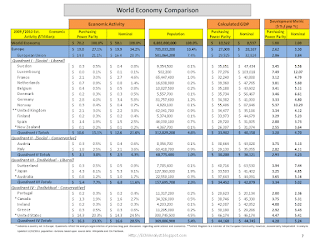Beliefs? Systems[Methods]? Authority? Results?
Initially wanted the beginning phases of dialogue to discuss this topic while including many of the graphics I have prepared up to this point. However, after including the needed graphics, an extended introductory essay would make the post too long. Thus, follow-up posts will explain and refer to the relationships among the graphics relative to current economic experiences and associated coordinations (Ideology strategies). Including the influence of religious and biblical interpretations on societal-industry economic development; stereotypes-beliefs-legal influence probabilities; tactics to fraternal obligations using political constituencies / institutions for advantage; resource ownership financing benefits resulting from economic leadership; and the
Note: Preferences based upon a statistical sample of population responses (non-significant R2).
U.S. based Development Metric is 1.00, the 0.96 avg reflected in the statistical analysis is a result of non-reconciliation of state population data variability to total population.
1. Roswell [timing, timeline]
2. Military hierarchy infiltration
3. Intelligence Organizations / Fraternal (secrets) "agreements" - (J.E. Hoover)
4. Technology / Corporations / investment [military spending history]
5. Political infiltration / Elections [morality focus / leverage]
6. Conservative Ideology & Church [worship/ financing/ Coptic - Mystic abilities?]
7. Relationship Privacy Protection fraternal "royalty" fee? [morality?]
8. Legislative branches of government [banking industry?]
9. Medical - Science research - education institutions (information collection)
10. Human Genome / DNA studies control / stereotypes & procreation exploitation?
11. Executive influence ["NWO" --> Faith politics --> Change? (banking crisis?)]
12. Intelligence Special action plan (strategy) reveal? Social "fraternal" commitment? Constitutional? No!
*re: Relativity Management Theory XX and XY [Episode I]: Time - Space - Dimensions and Technology Updated: August 26, 2016 [added video]






















